|
|
|
|
Products mentioned in this Article
--None--
|
|
|
|
|
|
|
|
|
 |
|
|
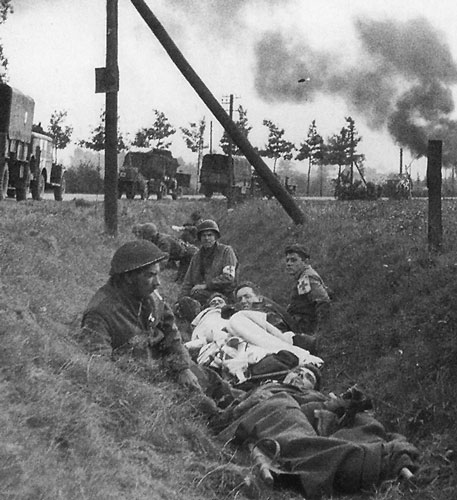
|
Battlefields of the Netherlands
with Mike Haught
Far from being flat and featureless, some of the Dutch landscape is crossed by canals, soggy polder, and raised roads while other areas are built up into large cities, such as Nijmegen, Arnhem, and Amsterdam. In this article I’ll talk about how to recreate these unique battlefields on your tabletop.
The Netherlands is a peculiar country in that a large portion (about 20%) of the country is made up of land reclaimed from the North Sea. This process began centuries ago and has since developed into a complex system of drainage canals, dikes, and polders (the spaces between the canals and dikes).
|
Water levels in the canals were previously raised and lowered using
wind-powered pumps, or windmills. More recently, however, the famous
Dutch windmills have been replaced by motorised pumps. The cross
sections diagram below shows how the Dutch polder system works. The key
feature here is that most of the area is below sea level. The other
water levels are carefully maintained to serve the population’s needs.
During
World War II, the Netherlands was the path of the German invasion in
1940 and many of the same objectives, such as Nijmegen and Arnhem, were
also the centre of the Allied invasion over four years later in
September 1944. |
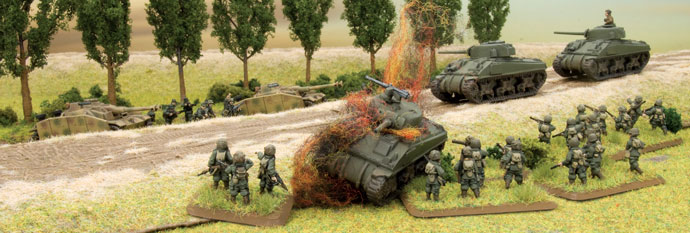 |
The Meuse, Rhine, and Scheldt
Three massive rivers, the Meuse, the Rhine, and the Scheldt, come together in the Netherlands, each feeding a massive network of canals between them. Holland’s largest cities are settled along or near these major rivers. Arnhem sits on the Rhine, Nijmegen is situated between the Meuse (Maas) and Waal rivers, and the Belgian city of Antwerp sits at the base of the Scheldt Estuary. If your battles are based in one of these cities, it would be a good idea to incorporate a river into your battlefield.
Polder Country
Between the cities are large networks of canals and polder. In peacetime, the canals provide a vital travel option, but in wartime, these become difficult obstacles, barring the way for vehicles.
Roads were built along the dikes and canals that enclosed the polder fields. These raised roads provide access to the local villages and cities. They were also the only way to reliably get things like tanks from one point to the other. These rural roads were no wider than perhaps two tanks side-by-side, making it quite easy for the defender to delay the enemy with roadblocks and ambushes.
The spaces between the canals and dikes is called polder. This ground is where crops and fields are planted. They can be as wet or as dry as needed in peacetime, but in wartime they are often intentionally flooded or waterlogged to force vehicles onto the raised roads.
|
 |
Crossroads can be used as deadly strongpoints where the defenders can deploy along the crossroad and shoot at the enemy coming along the main road. To make matters harder for the attacker, their tanks and vehicles will be driving along raised roads, making them easy targets silhouetted against the blue sky.
Fighting in polder country was one of the most difficult battlefields to contend with, and it only got harder when the battlefield nears the sea.
The Scheldt Estuary
The Scheldt Estuary has befuddled invading armies for several centuries. The estuary leads to the deep-water port of Antwerp. As a part of Hitler’s Atlantic Wall, it was heavily fortified with coastal guns, sea mines, and bunker complexes, especially on the man-made island of the Walchren and the Breskens region directly south.
In defending this area, the Germans took full advantage of the polder system, flooding the regions between their several belts of fortifications. All of the challenges posed by polder country were amplified by the presence of German fortifications, bunkers, and obstacles.
Your Battlefields
For tabletop gaming, you can really go all out with your Dutch battlefields, from adding windmills, to raised roads, and soggy polder. However, as a cautionary note, be careful about adding so much that it puts players off. The real campaign through Holland was a long and tedious battle, but that doesn’t mean your battles have to be as well. So, with that in mind, let’s have a look at a few examples and ideas for your Market Garden battlegrounds!
|
Hell's Highway
Between all of the raised roads the ground is uncommonly flat. It is quite open and anything caught inside could be shot at from all angles. This prompted troops to cling to the sides of the raised roads for cover. Flooded spaces offered their own challenges and were used by the Germans to slow the Allied advance.
You can model your polder in a few different ways, and each space can have its own separate set of proprieties.
Flooded Polder
Once the Allies gained ground, the Germans flooded the fields and they became boggy and tough going, even for infantry. Model this by having the area between the roads filled with one or more swamps. You can rate this area as either Difficult Going or Very Difficult Going, depending on the density of swamps in the space.
Dry Polder
In some fields this ground was sold and dry, allowing tanks to try and detour around the road. Model this
by having the area between the roads empty with the exception of a field of crops or a copse of trees. The area might still be rated Slow Going (but not necessarily so), but at least it is free of Bogging Checks.
Windmills
Windmills are a common sight in Holland. Check out the Flames Of War Website for a step by step article on how we built ours.
|
| Below: An example of a Hell's Highway battlefield. Click on the image to view a large version. |
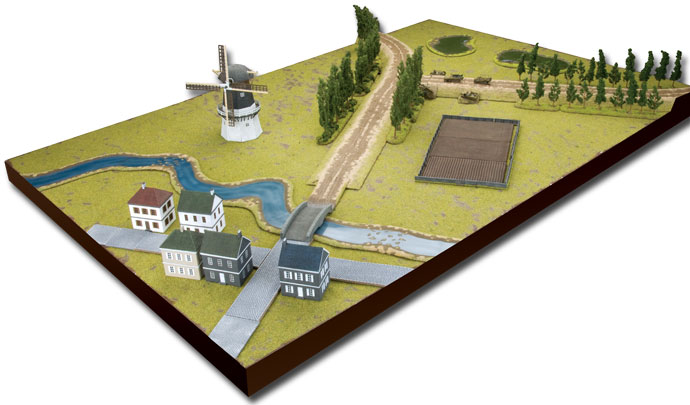 |
Canals
Canals are essential to the polder system. They cross the Belgian and Dutch fields, connecting larger canal and river systems together. Canals have steep and straight banks. Not all canals are lined in concrete, with most being made of earth. They come in all varieties of width from a few yards to dozens of yards.
Your battlefield may have canals crossing it, offering concealment for troops hiding along the banks. Depending on how you and your opponents rate the canal, vehicles will find them Slow Going or even impassable when attempting to move across it.
Light Bridges
Dutch farmers would have small foot bridges for easy access over small water obstacles such as canals and streams. These were also constructed by engineers to help get infantry across while a larger bridge was being built for heavy equipment.
Add some light foot bridges to your canals and small water features to give infantry a small advantage over vehicles.
|
Villages
Like
everywhere else, Dutch villages congregated in places where rivers and
road networks intersected. These settlements could be as small as a few
buildings or as large as a dozen or more.
Wreckage and Battlefield Litter
Polder country funneled vehicles onto the few raised roads. With this concentration it became all too easy for the Germans to smash up the Allied tanks and vehicles and clog the roads.
|
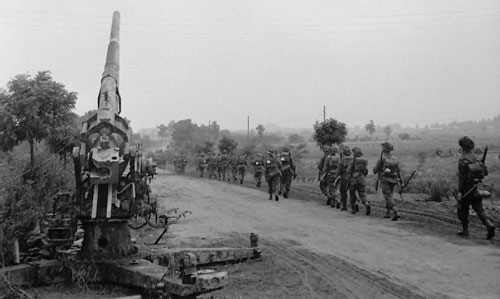
|
Feel free to model fields of wreckage, offering
concealment for troops hiding within. Vehicles find the wreckage Slow
Going when moving through it.
Tree Lines
Tall growing trees lined the raised roads. Poplar trees
are the most common as these were wetland trees and could cope with
growing in flooded areas. They were planted as windbreaks to help
protect the fields from harsh sea winds.
Add tree lines along your raised roads to offer some cover and colour to your battlefield. |
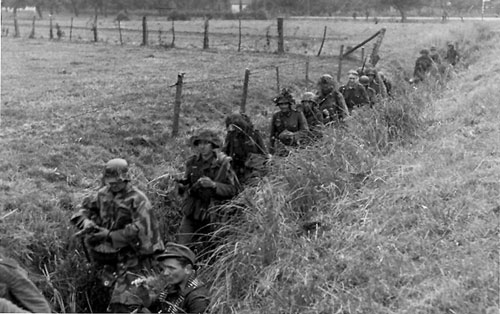 |
Raised Roads
Raised roads sit high above the polder fields. Their height is determined by how high the local water level would be if it was flooded. In some areas, the further inland you go, these raised roads are no more than a few feet high. The closer you get to the sea, the higher the roads need to be to stay above the water level.
Rural roads in Holland don’t usually need to avoid hills, forests, and
other large natural obstacles, so they are typically long and straight.
Intersections mark the corners of the polder fields and were usually the
most important tactical objectives during the fighting.
|
These
crossroads were typically well defended and zeroed in by enemy
artillery. The cross road offered excellent protection for defending
infantry and guns covering the main road. The attackers were forced to
use the high road, presenting easy targets, or charge across the open,
soggy polder.
The edges of all raised roads are Linear Obstacles
(see page 22 of the rulebook). Simple raised roads offer concealment to
teams hiding behind them. Taller ones offer Bulletproof Cover in
addition to Concealment. Like with any piece of terrain, discuss this
with your opponent before the game begins. |
Cities
City fights are a great opportunity to load up on buildings, roads, rubble, and more. However, remember that cities are not solid blocks upon blocks of buildings. Include open spaces, such as parks or rivers to offer some variety and challenges to both players.
|
| Below: An example of a City battlefield. Click on the image to view a large version. |
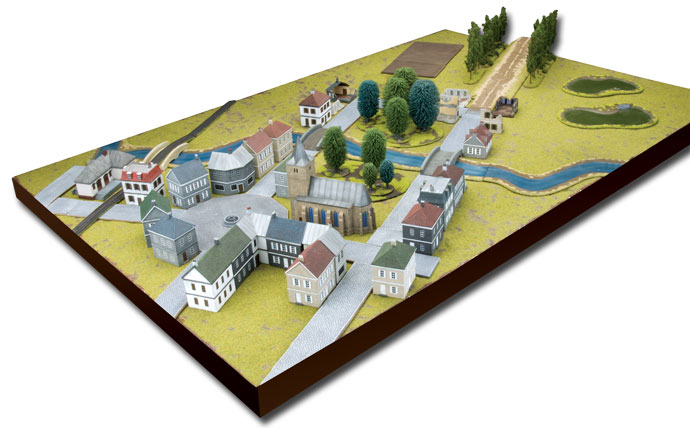 |
Parks
Large cities have a lot of parks. These are areas where troops can dig in and prepare defenses as though it was outside the city. Trench lines, minefields, and other similar fortifications can be deployed here. Some parks are so large, that you can actually fight a battle inside the city without spotting many (if any) buildings at all!
Parks are treated as normal ground, so troops can Dig In there. Trees or small woods offer concealment.
|
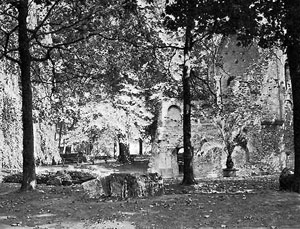 |
Railroad Bridges
Large cities usually have a railroad network tying it to neighbouring cities. Railroad bridges are just as important to an army, even though they are not ideally suited for road vehicles. With a little work (a lot less than building a new one) they can be modified to handle normal traffic.
Railroad bridges are rated as Slow Going.
|
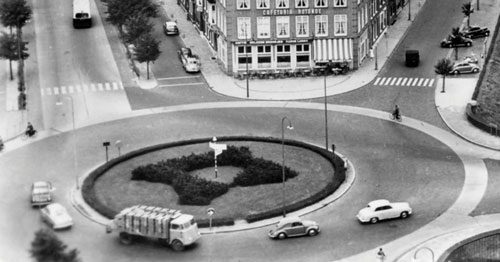 |
Traffic Circles
Traffic circles, also known as roundabouts, are a common feature in larger European cities. These help traffic to flow through the city in peace time, but in war they provide an excellent roadblock point with an all-round field of fire. Some circles have a monument or a structure in the centre.
Traffic circle are rated as a Road, unless rubble and debris have been added, perhaps reducing it to Cross-country or Slow Going (depending on how you wish to represent it).
|
Highway Bridges
Highway bridges are the best way to cross large rivers. The require little engineering work and can be used immediately upon capture.
Highway bridges are rated as a Road, unless rubble and debris have been added, perhaps reducing it to Cross-country or Slow Going (depending on how you wish to rate it).
|
Large Rivers
Big settlements were established along major rivers, such as the Rhine and the Waal. These rivers are massive and require a serious effort to get troops across.
Rivers are Impassable, but as usual, your table should include a crossing every 2 feet (60cm) or so to make sure the battlefield doesn’t give one side a major advantage over the other.
|
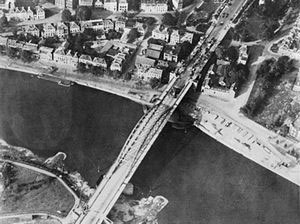
|
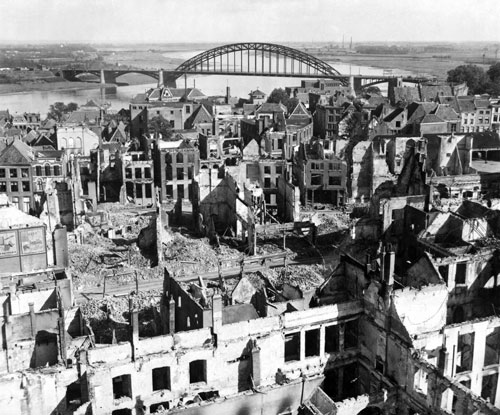
|
Rubble & Ruined Buildings
Euling’s men demolished all of the buildings and vantage points that fell outside their defensive perimeter. When the Allies finally launched their attack, they found that they needed to contend with rubble and debris before even encountering any SS troops.
The Flames Of War rulebook rates rubble as Very Difficult Going (page 30). Infantry and Gun teams sheltering in rubble also benefit from Concealment and Bulletproof Cover.
|
The Walchren
Abandoned Bunkers
The Walchren was one of the most heavily fortified portions of Hitler’s Atlantic Wall because it guarded the approach to Antwerp with absolute authority. The island, as well as the Breskens area to the immediate south, contained hundreds of bunkers, sstrongpoints and obstacles. Many of the bunker complexes housed huge anti-naval guns, which engaged the Royal Navy and caused grevious losses.
When these strongpoints ran out of ammunition and the main bunkers were abandoned, the defenders turned to counter the Allied infantry approaching from the flanks. At this point the bunkers (often pointing out to sea) were nothing more than massive obstacles.
Treat abandoned bunkers like any other building except that they cannot be entered by tanks or vehicles under any circumstances.
Abandoned Obstacles
Bunker complexes had a lot of supporting obstacles to guard them from infantry assaults, such as barbed wire, minefields, and anti-tank ditches.
Feel free to add some of these obstacles to your battlefield, but make sure to place them before you roll to see which table edge players will begin from. This will help make sure that the game is more balanced.
However, if one or both players have fortifications in their army, it may be a good idea not to place abandoned obstacles on the battlefield as the two might combine to make things very hard!
Dikes
The Walchren is entirely made up of reclaimed land. The edge of the island surrounded by a large dike that keeps the sea water from covering the middle area.
A single raised road should run the length or width of the table. On one side whould be land and the on the other should be the sea or the shore. The dyke offers the same benifits as the raised roads on the previous page.
|
| Below: An example of a Walchren battlefield. Click on the image to view a large version. |
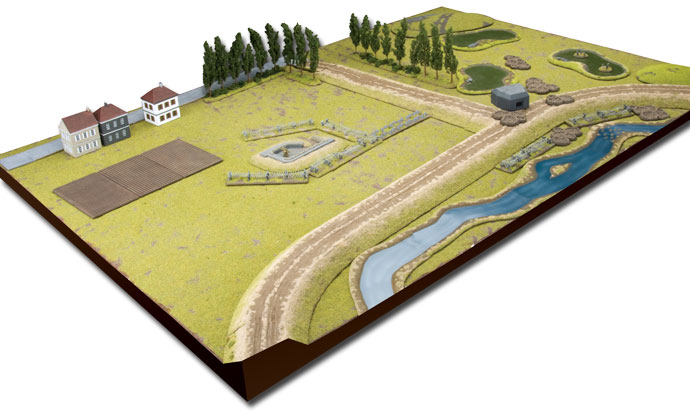
|
Flooded Fields
After the Allies bombed the Walchre’s dike the island was flooded. Only small slivers of land along the dike were above sea level. The Allies used their amphibious vehicles to help navigate the muddy mire inland.
Like with the flooded Polder on the previous page, a flooded field can be represented using a series of swamps.
Dunes
As with most coastal areas, sand dunes have formed around the sea’s edge on the Walchren. These were essentially hills on an otherwise very flat piece of land.
Dunes use all of the normal rules for Gentle Hills (see page 30 of the rulebook) but can also be rated Difficult Going, owing to the loose sand exposed between the coastal grasses in some areas.
Sea
Seaboarne amphibious assaults are hard to model without having a dedicated seaside table. For our table here, we have modeled the sea using a river. We assume that the river itself and the space up to edge of the table is Impassable to all teams except amphibious ones, such as DUKWs or LVTs.
|
Bomb Craters
The Allies bombed the Walchren’s dikes and flooded the inside of the island with sea water. This was accomplished using heavy bombers which tore through the dikes and left massive fields of craters behind.
Add areas of massed craters to make the ground Difficult Going. Infantry and Gun teams taking shelter inside are also Concealed and in Bulletproof Cover.
~ Mike.
|
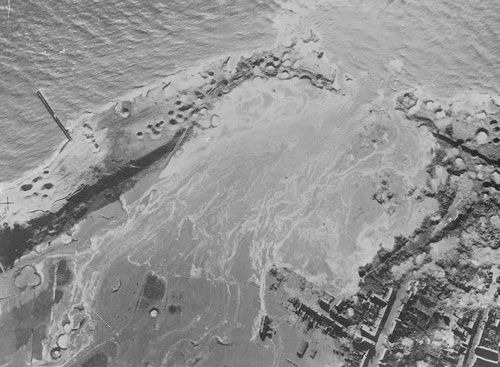
|
Last Updated On Monday, April 22, 2013 by Blake at Battlefront
|
|
|